Nintendo Switch OLED review: the Big N’s games console just got bigger and better
The Nintendo Switch OLED is this year’s must-have gaming gadget


The best thing about the Nintendo Switch OLED is how easily you can switch between playing on your TV to gaming on the go - that hasn't changed. What has changed is what it's like to play on the handheld console. Whether you're using it alone or with friends, the bigger brighter screen makes everything more enjoyable.
-
+
OLED display is stunning
-
+
Long-lasting battery
-
+
Premium design and build quality
-
+
64GB of internal storage
-
-
Not as powerful as PS4 or Xbox One
-
-
Handheld console is quite big
Why you can trust T3

To cut right to the chase of this Nintendo Switch OLED review: if you're buying a Switch for the first time and you want the very best of the bunch, get the Nintendo Switch OLED. But if you'd rather save money then you should buy the Nintendo Switch instead because they aren't that different.
So what's changed? Well, the new OLED model has had a shakeup when it comes to the display and there have been a few small design tweaks, but it’s pretty much the same piece of kit when you look under the hood. That's why it's not really worth upgrading the console if you already own the older model.
Because nothing has changed under the hood, the Nintendo Switch OLED still won't match the PlayStation 5 or the Xbox Series X when it comes to power, although it is a more refined version of the console with an improved experience in tabletop and handheld mode.
You should buy one if you want something that the whole family can enjoy. With titles ranging from the brand new Metroid Dread to the cult-favourite Super Mario Odyssey and fan-favourite Animal Crossing: New Horizons, there’s literally something for everyone. Take a look at T3's guide to the best Nintendo Switch games for more.
The launch of the Nintendo Switch OLED was one of the most anticipated tech releases of the year, and I’ve managed to get my hands on one to bring you this comprehensive review. Read on to find out everything you need to know about Nintendo's most impressive piece kit. I'll be updating this review as and when I find out new things about it.
Nintendo Switch OLED review: video overview
Nintendo Switch OLED review: what’s new
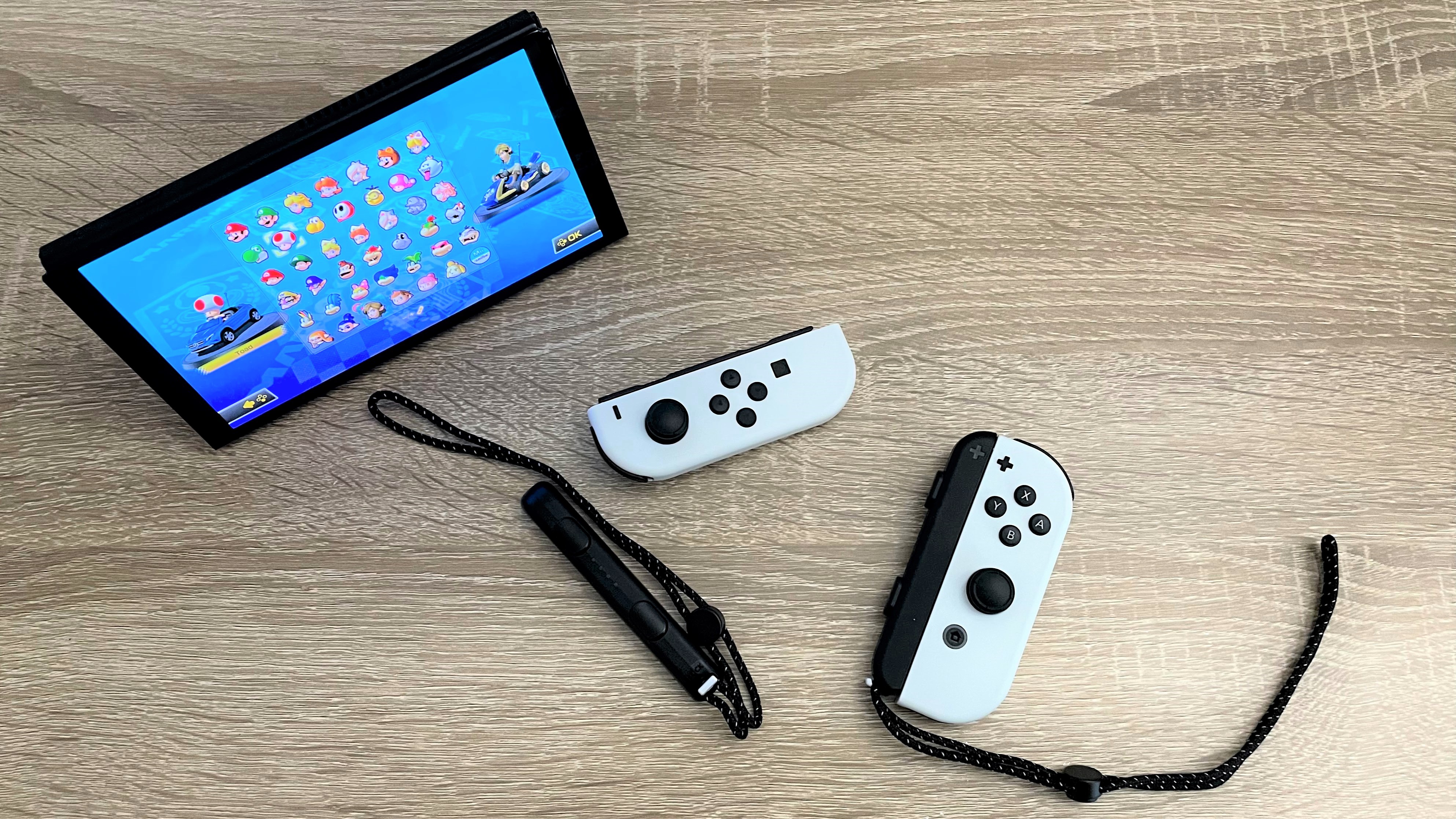
So what’s the difference between the Nintendo Switch and the Nintendo Switch OLED?
Firstly, the screen is bigger - it’s 7inches on the OLED model, where it was 6.2inches on the original. But the biggest difference is in the screen technology, on this model you get an OLED touchscreen as opposed to a simple LED touchscreen. That means the pixels are no longer illuminated by backlighting, they produce the light themselves - in laymen’s terms, you should get a brighter screen from OLED with more contrast and better viewing angles. It won’t be more detailed though as they’ve kept the resolution at 720p for handheld and 1080p when docked.
Get all the latest news, reviews, deals and buying guides on gorgeous tech, home and active products from the T3 experts
Another difference is in the internal storage, which has doubled. It was 32GB on the Nintendo Switch, whereas the Nintendo Switch OLED boasts 64GB. Both are expandable using a MicroSD card, though. Plus, Nintendo has enhanced the quality of the audio produced by the stereo speakers.
On the new white dock, there's now a wired LAN port so you can connect the dock directly to your Wi-Fi router using an ethernet cable, which should mean much more reliable internet speeds.
Lastly, there's a more robust kickstand on the new OLED model, fixing a problem with the slim and somewhat flimsy stand that plenty complained of before.
Nintendo Switch OLED review: price and availability
You can buy the Nintendo Switch OLED for $350 in the US, £309.99 in the UK and AU$539 in Australia. To see where you can pick one up, take a look at the widgets on this page.
At launch, it is more expensive than the original Nintendo Switch which started at $299.99 / £279.99 / AU$470 although you can pick one up cheaper than that now.
Nintendo Switch OLED review: what’s in the box

In opening up the Nintendo Switch OLED box for the first time, the first two things you see are the Joy-Con controllers and the display. It’s an exciting moment, let me tell you.
Remove that layer to reveal the docking station, the power cable and an HDMI to hook it up to your TV. Below that, you’ll find the two Joy-Con straps and the Joy-Con grip which gives you a more traditional way to use the controllers.
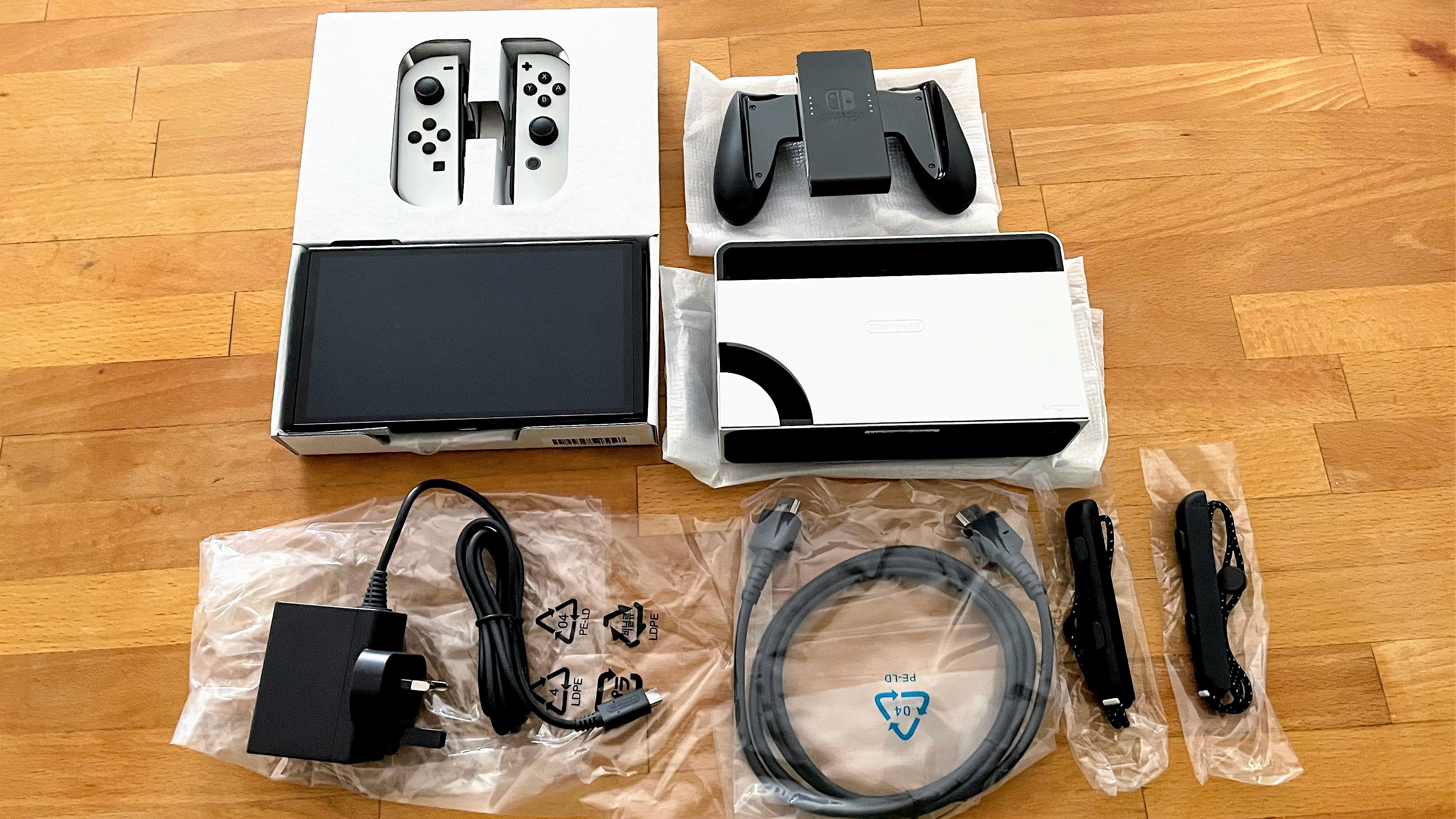
Setting it all up is incredibly easy, you just plug it in and start the console up. Log in to your Nintendo account to access all of your games, or if don’t have a Nintendo account yet, you’ll need to set one up to access the Nintendo eShop. Alternatively, you can insert a Nintendo game card to start playing.
Nintendo Switch OLED review: display and design
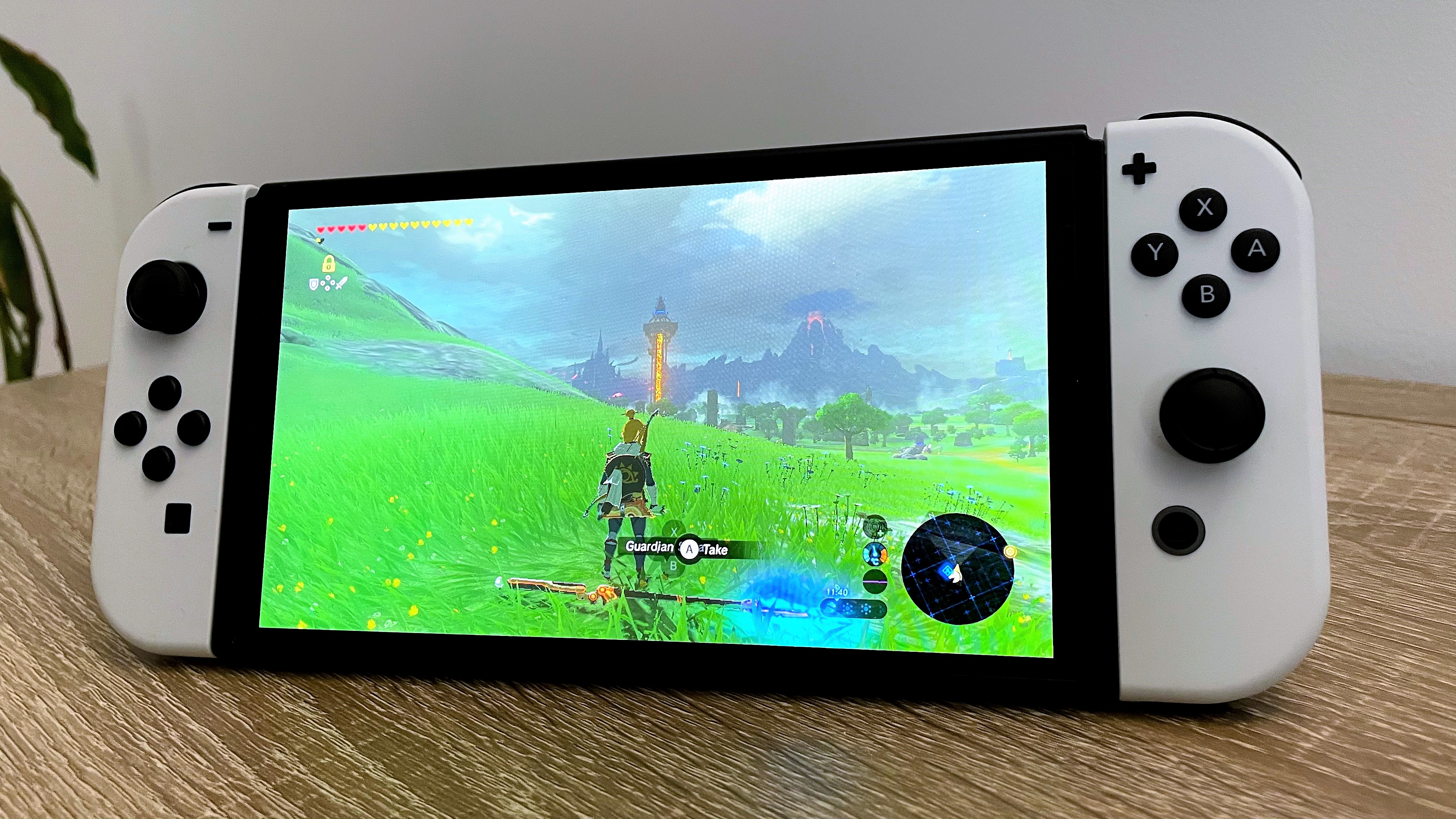
The 7inch OLED display is a beauty, even though the resolution is still just 720p. Games like The Legend of Zelda: Breath of the Wild really showcased the potential of the new OLED screen - it’s bright, colourful and the contrast has improved massively. Even on the simple Home screen, lettering comes across with clarity and colours are vibrant, popping out of the display.
Where you really make the most of the new 7inch OLED panel is in tabletop mode where two players both use the display at the same time using a Joy-Con controller each. It makes loads of sense to have that bit more screen real estate which combined with the improved viewing angles means you can both see the display much better.
If you plan to play in handheld mode a lot then it’s definitely worth spending the extra cash because the OLED model has improved brightness and contrast. In terms of quality, it feels more like using a small tablet than the majority of handheld consoles I’ve used in the past.
You’ll recognise the Nintendo Switch OLED’s design because it’s almost identical to what came before it. There's a tiny power button and volume controls on the top left of the frame and the game card slot sits on the opposite side. On the underside, there’s a USB-C charging port and two system connector holes which attach the console to the dock.
The OLED model measures 102 x 242 x 13.9mm with the Joy-Cons attached which is just a little taller than the original. It weighs just over 20g more now as well, so 420g in total. Despite a slight increase in size, it’s still comfortable to use in handheld mode, although you’re less likely to be able to slide it into your pocket.
The two thin Joy-Cons slide down onto the edge of the screen using the side rails. The left controller has an L button and minus button with the Left Stick below it, followed by directional buttons and a capture button to take screenshots during play. On the right controller, there’s an R button, plus button, the A/B/X/Y buttons, the Right Stick and the Home button. Each Joy-Con has an SL and SR button on the inside edge.
When used separately during multiplayer games, both controllers can be used horizontally in exactly the same way with the same layout.
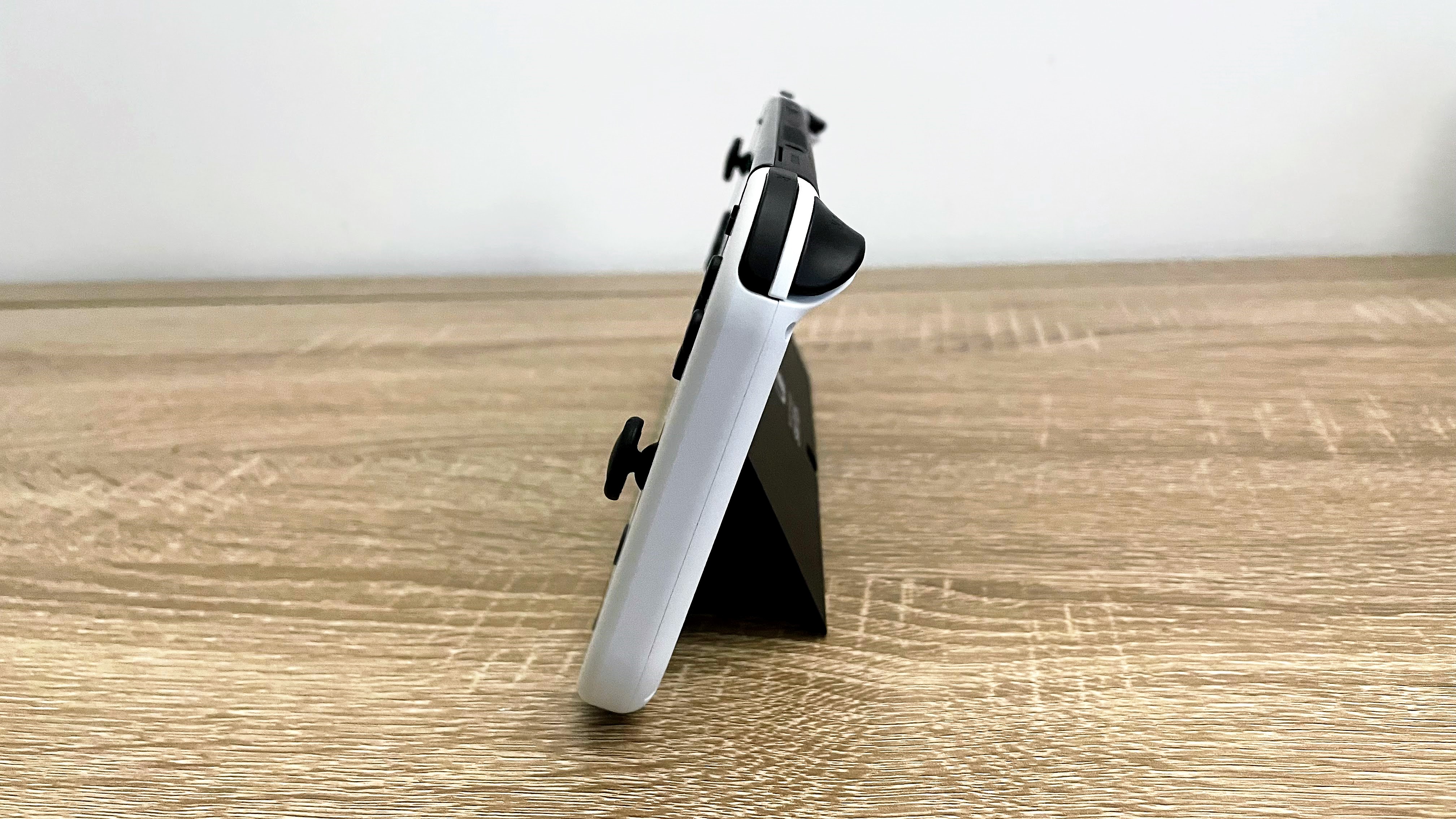
The downwards facing side of the right Joy-Con houses the IR motion camera, although both controllers can use motion tracking in more physical games like Just Dance as they both have an Accelerometer and Gyroscope.
The whole device looks sleek and modern, partly aided by the very slim bezels. You won't be disappointed by the build quality either as it feels solid and premium for the most part.
On the back, the kickstand now stretches across the whole length of the screen which makes it much more stable to use propped up on a table, with the controllers attached or without. It’s made from plastic so still doesn’t feel as tough as a metal stand would have done, but it’s definitely an improvement on what was there before.
To attach the Joy-Con straps, you just slide them on, click them into place and the SL and SR controls automatically switch over to the larger buttons on the straps. They're particularly handy for multiplayer games like Mario Kart Deluxe 8 where you want more grip on the controller throughout the game. They add more space to hold it as well as more prominent, easy to find buttons. You do have to make sure they are attached properly as it can affect the functionality if they aren't.
The included grip is another fantastic accessory to have in the box, making the two sets of controls much easier to use simultaneously in solo play. If I were to nitpick, one design flaw with the grip is just how big it makes the controller, it feels almost too big considering the controls on each side are packed so tightly together.

Nintendo Switch OLED review: dock and cabling

The dock on the Nintendo Switch OLED is white, where it was black on the original. It's not a major change but it does affect how it looks by your TV.
It’s very easy to hook up the console to the dock, it’s literally just a case of sliding the display in and placing it down.
The docking station is made of plastic with a detachable panel on the back where you plug in the USB-C and HDMI cables. There’s also a wired LAN port to connect it directly to your Wi-Fi router using an ethernet cable - this means you’ll be able to rely on the console to get the fastest internet speeds your home network allows for which in turn will massively improve your gaming experience.
Having most of the ports tucked away behind the rear panel keeps everything neat and tidy by your TV, you won’t have the eye-sore of loads of cables hanging around.
Elsewhere on the outside of the dock, there are two additional USB ports that can be used for a number of different things, like charging your Nintendo Switch Pro controller or even the Joy-Cons when they’re attached to the grip. You can use the ports to attach a USB keyboard to make typing in logins and passwords much easier as well.
There's no 3.5mm audio input so you won't be able to hook the Nintendo Switch OLED dock up to a wired audio device.
Nintendo Switch OLED review: performance and sound quality
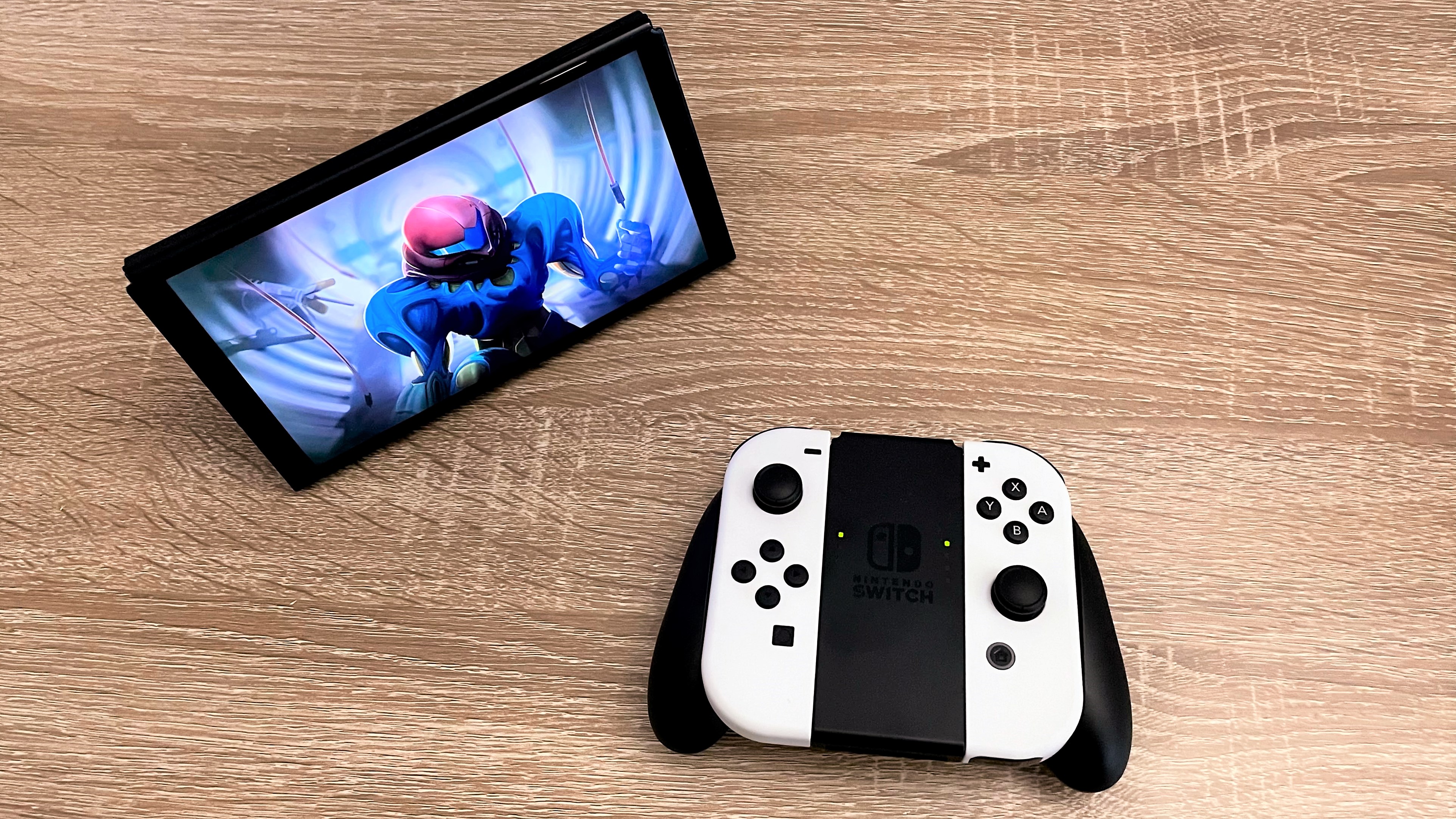
You can't talk about performance without mentioning the screen again. It's the best we've seen on a Nintendo console, and I can't stress that enough - it really does make the whole experience better, even on less colourful games like Metroid Dread. Whether you're playing alone or with someone else, you can see more, do more and enjoy it more because of it. And it was already pretty enjoyable before.
A feature worth mentioning is Automatic Brightness. Using sensors on the console, the brightness on the display is adjusted depending on where and when you are playing - that’s perfect for those who lose themselves in a game and don’t notice that they're squinting as the room gets darker.
As what’s under the hood is identical across the old and the new versions of the Nintendo Switch, there isn’t much to say there. Powered by the NVIDIA customised Tegra processor the Nintendo Switch OLED is fast, responsive and a pleasure to play. I had no issues to speak of when it came to gameplay, loading times or navigating the interface, it all works as you expect and want it to.
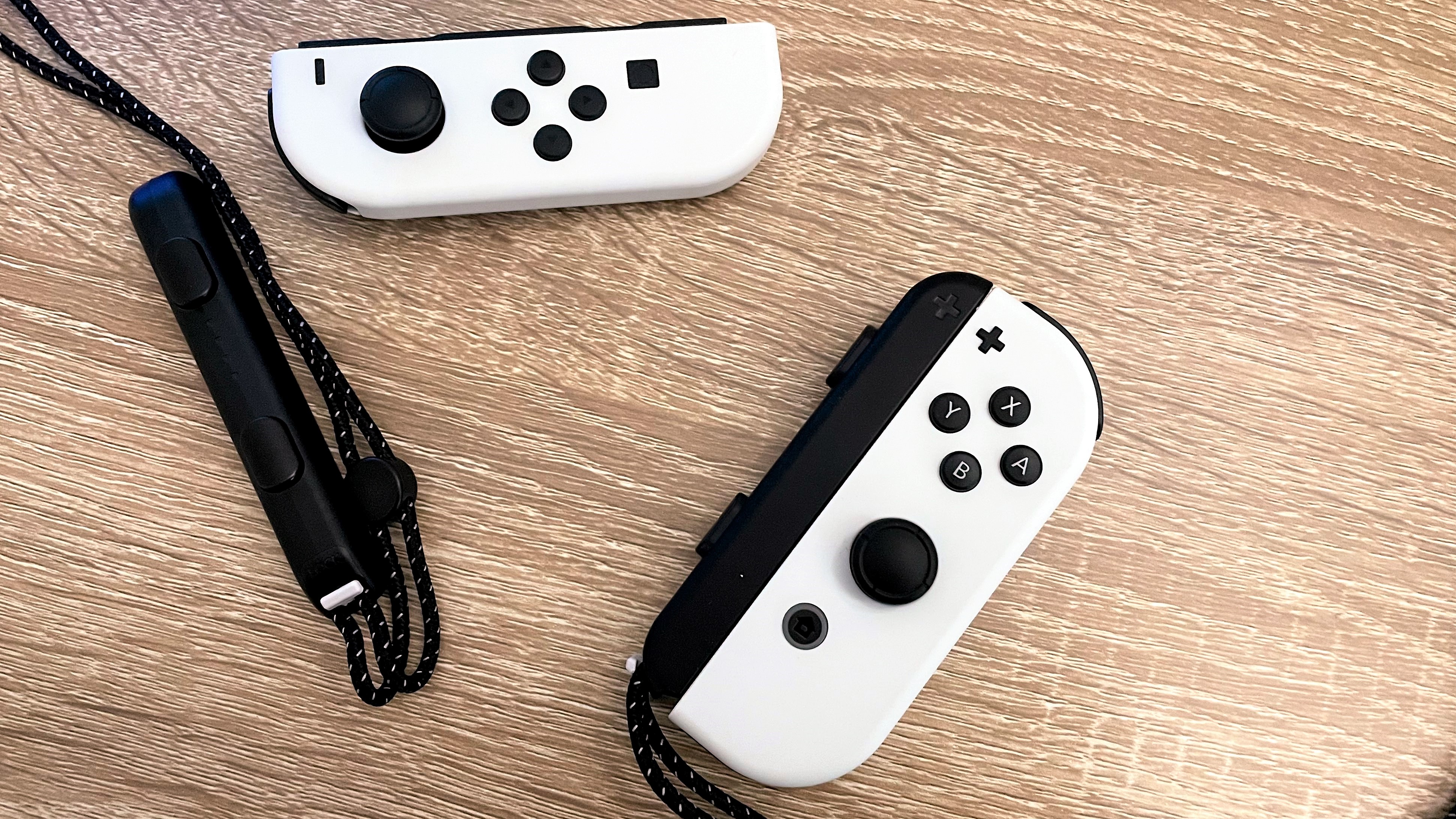
There’s 64GB of internal memory here which is loads, but if you do run out, you can expand it using a MicroSD card which slides into the back panel, beneath the kickstand. The only problem with that is that it’s not protected from the elements as much as if it were in a covered slot.
In handheld and tabletop mode, you’ll be able to make use of the new enhanced stereo speakers which are very loud and clear considering the size of the console, although the sound does come out a little tinny when the volume is turned up all the way. To improve it, you can hook the console up to your own Bluetooth audio devices but do bear in mind that you’ll only be able to use up to two controllers while you have one connected.
Nintendo Switch OLED review: battery
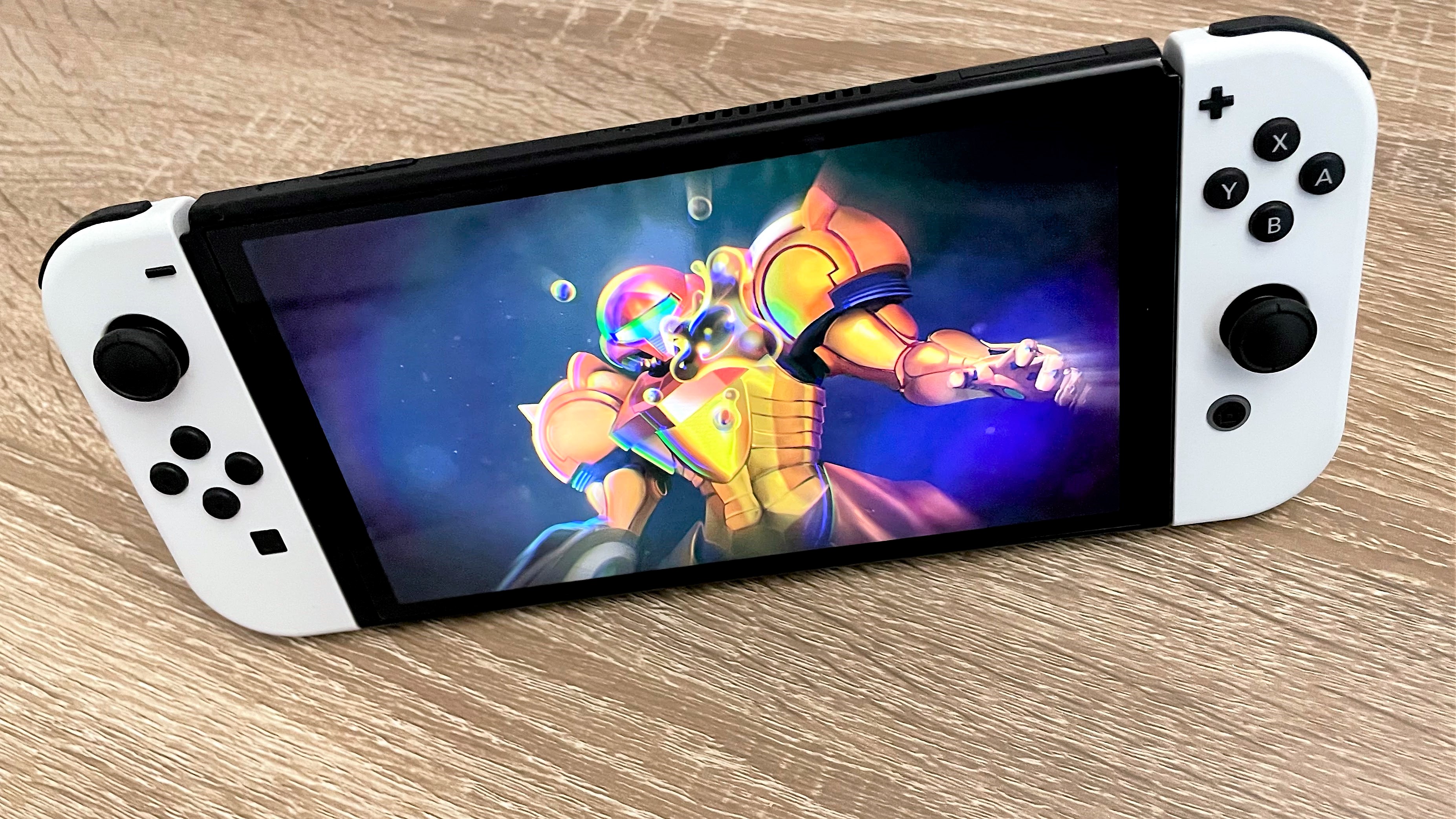
The Nintendo Switch OLED has a battery life of 4.5 to 9 hours which is the same as the original and plenty for most people.
It would have been nice to see an improvement in the way of battery life but it is still quite impressive that they have managed to keep it the same despite having a more demanding display.
Nintendo hasn't been able to increase the speed of charging either, when powered off or in sleep mode, it’ll take about 3 hours to recharge.
When it comes to the battery life of the controllers, I highly doubt you’ll ever run out of juice, I didn’t. They should both last about 20 hours and they take 3.5 hours to fully recharge.
Nintendo Switch OLED review: verdict

The Nintendo Switch OLED has come on leaps and bounds when it comes to how it feels to play on the go, as opposed to when it’s hooked up to your TV (that side of things is just as pleasurable as it has always been).
For those who plan to play a lot on their own in handheld mode, the new OLED panel makes games truly come to life. I was blown away by how beautiful and vibrant the graphics look - it makes the whole experience incredibly enjoyable. But even if you want to buy a Nintendo Switch for your whole family or household to use, the bigger brighter screen on the Nintendo Switch OLED makes a lot of sense because you’ll get a better view of the screen when you play multiplayer games in tabletop mode.
The only reason I would tell you not to buy this console is if you already own the Nintendo Switch. Under the hood, they’re almost exactly the same so it’s not really worth splashing out this much cash just to get a slightly bigger, better screen. Of course, there are a few other improvements but they are minor, and won’t make it worth the upgrade.
If you are looking to buy the Nintendo Switch for the first time then this model is the one you should get. The Nintendo Switch OLED is without a shadow of a doubt their best games console yet.
Nintendo Switch OLED review: also consider
If you don’t want to splash out this much cash and you’re not planning to play that much in handheld or tabletop mode, then you should buy the original Nintendo Switch instead which is now available for as little as $299 / £259 / AU$427.
The price of that might still make your eyes water and if you don’t think you’ll make much use of the TV dock at all, then no fear, you can buy the handheld only version which costs $200 / £180 / AU$260 at the time of writing.
The Nintendo Switch Lite isn’t as good as the Nintendo Switch or the Switch OLED because it doesn’t switch between a handheld and TV gaming console but you will get to enjoy all the same games on a very portable device for much less money.
- Here are the best gaming TVs you can buy

Yasmine is the former Reviews Writer for T3, so she's been knee-deep in the latest tech products for reviewing and curating into the best buying guides since she started in 2019. She keeps a finger on the pulse when it comes to the most exciting and innovative tech – and since departing has also held a role as Digital Spy's Tech Editor. In her free time, you'll catch her travelling the globe – the perks of being a freelance tech expert – tending to her plants when at home and, but of course, planning her next big trip.